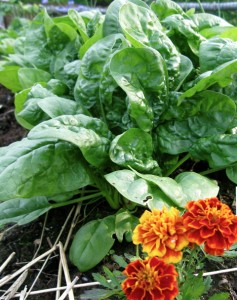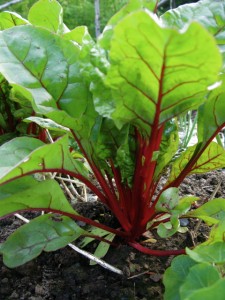Composting Basics, for Beginners…
Learning to make your own compost is one of the most economical and effective ways to build fertile, organic garden soil. Fortunately, it is also one of the simplest garden skills to learn. Plants grown in compost-supplemented soil tend to be stronger, healthier and more disease resistant. Organic garden compost adds valuable nutrients to soil, enhancing vegetable and fruit quality and yield at harvest time. Compost is created naturally on earth throughout the seasons, with dead matter piling and decaying, building rich soil to support new life. As gardeners, when we make compost we imitate nature by rapidly creating layers of rotting material in a small space. Turning piles of composted plant material speeds up the natural process of decomposition by heating up and aerating dry, green and brown layers of organic waste from our kitchens, gardens and fields.
Getting a compost pile started can be quite easy. Â As your interest in gardening grows, more permanent or attractive bins and tools may become desirable. However, composting is a very easy garden skill to learn, and it need not be expensive, time consuming or difficult. Â The first step is to create a contained area for your pile.
Building a simple compost bin does not require any carpentry skills. The most basic bin is made of 4 straw bale walls stacked up four feet high. Another very easy, no-nonsense design requires 15 feet of wire or snow fencing and a pair of wood or metal stakes. Â If you are using wire or snow fencing, form a cylindrical shape and set the bin in an area of loosened soil. Drive two stakes or saplings at least one foot into the ground, on the inside of the bin, at opposite midway points. Â Three or four stakes evenly divided are even better for stability. Attach the bin to the stakes with wire or twine, and you are ready to start !
Once you have your bin set up, add a few inches of clean straw to the bottom. Next add water to the straw slowly with a watering can to make it damp, (but not soggy). Top this first layer with a 2-6 inch layer of loose “green” material. Green material consists of fresh organic cast-offs, such as grass clippings, kitchen scraps, thinned seedlings, or spent vegetable plants. Adding pulled annual weeds to a compost bin is also acceptable (it is wise to keep perennial weed roots out of your bin, and diseased materials should always be burned or otherwise disposed). On top of this “green” layer, add a half inch or so of garden soil or well rotted manure (never dog or cat manure). Â You can also add some mature compost from a friend’s compost pile as a starter. Keep building your pile in these layers over a series of weeks. Each layer of compost should contain the described balance of dry materials, green materials and the brown layer of soil/manure/compost. Keep dry materials on hand in a shed or covered bin, and try to maintain steady layering. Some compost ingredients, such as grass clippings, tend to mat up. Â Add these materials in moderation unless you have enough loose matter, (such as vines or pulled plant stalks), to balance the mix. Â It is also helpful to ‘scatter’ the material into the compost bin, as opposed to dumping kitchen scraps into a solid pile on the heap.
As your pile grows, you can add shredded fall leaves and newspapers, chopped ornamental grass and other fibrous materials to the dry layer of your pile. The green layer should contain grass clippings and kitchen scraps (vegetables, fruits, coffee grounds, egg shells, etc.) as mentioned, but you can also items like deadheaded flowers and other easily rotted plant material from around the yard. Once you have created a batch of your own compost, a 1/2″ sprinkling can go in as the final layer. I also like to add green sand to my compost. Â Green sand can be found at most farmer’s supply stores. Â This is an organic supplement from ancient ocean floors, and it adds valuable potassium to the garden.
A compost pile needs to reach about 3′ high (be patient, as it will settle) in order to generate internal heat. Once your pile reaches this height, you can cover it with a blue or black tarp to help retain heat and keep out excess water during rainy periods. Many gardeners have two or more piles going at once, however this isn’t necessary unless you have a larger garden with a great need for compost. Once your pile is 3′ high, turn the compost with a garden fork — really mix it well to fluff and aerate the pile. You can also add some water if the mix seems dry, and then cover it again.  Keep turning your pile every few days –or at least once a week– until your compost appears dark and crumbly like good garden soil. Once the compost reaches this point, you are ready to pull up your bin, move it and start another pile. The old pile is ready to spread as mulch or add to supplement soil.
***
Article and photographs © 2010 Michaela at The Gardener’s Eden
All content on this site, (with noted exceptions), is the property of The Gardener’s Eden and may not be used or reproduced without prior written consent. Inspired by something you see here? Great! Please give credit where credit is due. It’s a small world and link-love makes for fond friendships. Stealing makes for bad dreams…
Do you enjoy visiting The Gardener’s Eden? You can help support this site by shopping through our affiliate links. A small percentage of any sale originating from The Gardener’s Eden site will go toward web hosting and maintenance costs. Thank you for your support!
***
3 Replies to “Composting Basics, for Beginners…”
Comments are closed.





Thanks for the useful info. It’s so interesting
Hi James, Thank you for following the blog. The Gardener’s Eden is just warming up ! I hope you will enjoy it, and look forward to reviewing your feedback in the future !
-Michaela
Great blog, I’m becoming a daily reader. : ), ~Sandra~ Thanks.